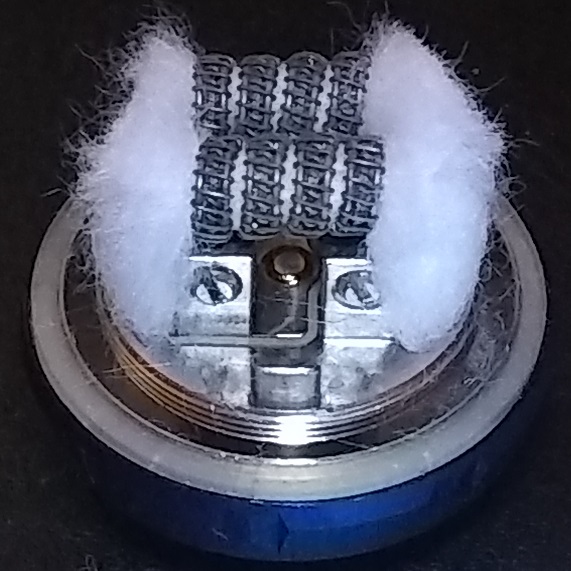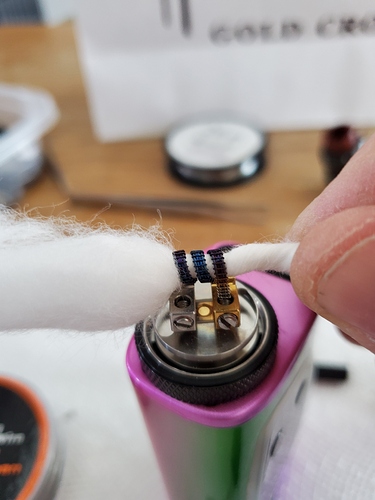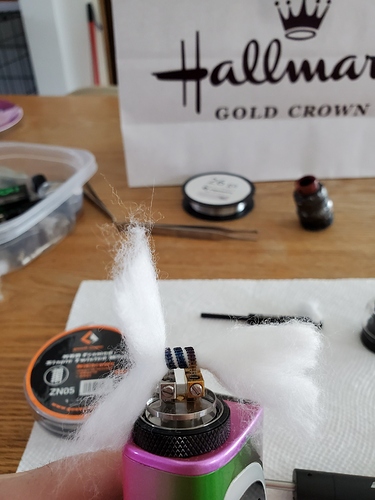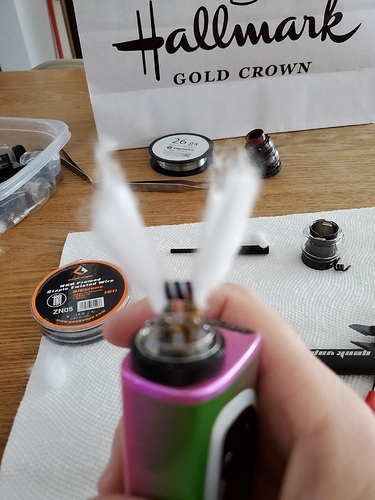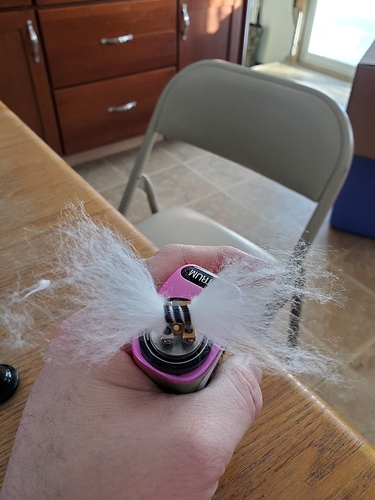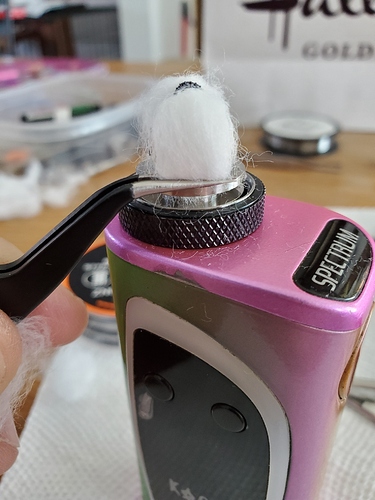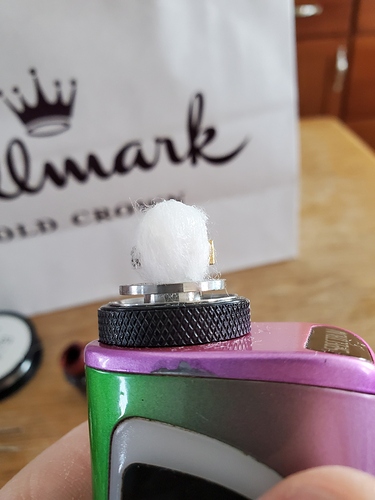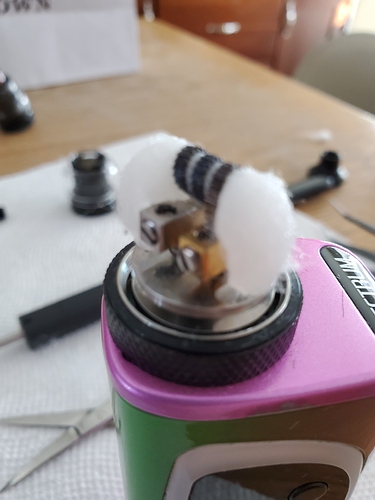Actually I use rayon in almost all my RTA’s and RDA’s. It’s the thickness that matters, not length.
I should have specified thickness. Apologies for any confusion.
So it doesn’t wick well if you use more or what other reason is it for?
I’m just trying to imagine it … but how do you fill your RTA wicking holes with only 15% of the wick?
I’ve found that if more than about 20% thickness is used, flavor loss starts to happen and the possibility of dry hits increases. The properties of rayon differ than cotton. Rather than soaking up the juice like cotton, rayon channels it or allows it to flow.
I don’t fill them. On the dead rabbit and kylin m rtas, I trim somewhat flush with the wick holes, but there is space that allows air to escape to avoid getting airlocked and dry hits. I do have to close the airflow when refilling to avoid oversaturation of the coil/spitting.
Sorry for drilling down on this but it’s only because I never got on with rayon and I’m a rational person, just trying to understand what’s going on…
As far as I understand vaping, flavor is produced by the flavor molecules being vaporized, together with base liquids. This happens by heating up a metal coil that heats up the liquids surrounding it. As far as my experience goes, no wicking material wicks fast enough to continuously feed the coil of liquids so you need to take puffs and give it (at least) a little time to feed more liquid to the coil.
Whatever happens away from the coil doesn’t really interfere with the flavor as long as you keep a good airflow in the chamber.
So using as much rayon as cotton in the tails should, in my humble opinion, not interfere with the flavor. If you say it is, I’m lacking the understanding why that is and that’s really what I’m after ![]()
I’ve read that the main difference between cotton and rayon is that cotton swells up with liquid and rayon shrinks. Which is why I’ve always been told to stuff the coil with rayon, so that even with the liquid, the wick keeps touching the coil or you’ll get hotspots, spitting and other unpleasant side effects from heating up bare, uncooled metal.
Wicking through cotton happens through capillary action. How is this different from rayon and why would that effect diminish if you have more/thicker wick tails? Is there any physics theory behind it? Just on sight, you’re dealing with similar materials made from fibers so most people would probably think it works in a similar way.
That is pretty much what I do with cotton too. The thing I don’t understand is how you fill your wicking holes enough not to have gaping ‘air’ holes that will flood your tank or leak empty in an instance. As I mentioned before, rayon shrinks when it gets wet. If you fill your 4mm id coil with rayon and only have a strand of 0.8mm (20%) rayon… or even a dual coil 2x3mm id and 2 strands of 0.6mm rayon… I don’t see how that could work in any of my RTAs (Steamcrave Plus, Zeus X dual, Blotto, Zesthia, …).
Do you have some pics (even if they’re grabbed from the www) to demonstrate that with a current popular RTA?
I have used Rayon for a couple years, I wick as tight as possible, that is the only difference than with cotton. I get what the OP is refering to even with Rayon if I do not wick tight enough or over heat it will burn out the center inside coil, cotton or rayon.
Post 41 has links to tons of info on rayon
Now that I think about it, I only have top airflow RTAs. So there is the possibility of leaking occurring in bottom airflow RTAs.
Here’s one with the Zeus.
It doesn’t look like 20% thickness in the picture.
I’ll rewick my dead rabbit later on today and show you how I do it. I use the same type of coil in my dead rabbit.
I personally find that rayon works/wicks best if it is squeaky tight in the coils with the tails thinned out considerably (perhaps this is just another way of saying what Deerslayer is saying). Cotton on the other hand is not packed between the coils as tightly (cotton wicks swell when they absorb e-liquid, rayon ones don’t. The thinning of the tails with the rayon increases the capillary action.
Sorry haven’t been able to get decent pictures on my tablet yet but getting very lost with all the comments on this post. Take the point that was made about keeping the shape with 29g 317L ss when wicking, however in trying to get about 1ohm to fit in my mtl tanks this is about as large as I can go.
I am using a Voopoo Drag with True, Amitt, Ares and Siren 2 tanks all very small beds.
Would really like to try using ss clapton coils between .8 and 1ohm. Any advice on suitable wire I can purchase in UK? Biggest problem apart from the short bed is the small diameter of the holes for the wire especially on the True.
Pretty much they way I should have said it. ![]()
@anon28032772 I got called in to work early tonight, so I’ll have to get pics tomorrow and post them for you.
Alright @Deerslayer you done went and opened up the can-o-worms now LOL.
I really only DABBLED in Rayon (just too damned good and hooked on my cotton), but refresh my FAILING memory would ya ?
Cotton you pack medium tight (in the coils) as it expands somewhat/slightly when soaked. Rayon is the OPPOSITE, i.e. you need to pack it really tight (in the coils) as it shrinks somewhat/slightly when soaked, right ?
I’d never heard anything about tail length issues. What did I miss ?? I’ve got a huge bag-o-Rayon that I’ve not really ever played with.
Hmmmmm, well THAT doesn’t sound good. Ball Kick +1, Rayon -1 ??
My thoughts on rayon are verbose enough on some other threads. Having spent over 40 years in the plastics industry, you couldn’t get me to touch rayon. Each to our own poison though. For the record, I rewick mine daily. I was strictly a KGD user, but with advancing arthritis in my hands I’ve switched over to Demon Killer slacker cotton just so I don’t have to cut it.
Rayon is made from wood pulp.
Tail length doesn’t matter, tail thickness does. Less is more. What I basically do is twist the rayon tight and wick it through the coil. When I start wicking the coil I will have to twist it as I’m pulling it through the coil. It will distort the coil if you aren’t careful. After it’s in the coil, I trim the bottom 50% off the tails. The remainder is thinned out to 20% or less; I’m usually around 15%. For me, trimming the bottom 50% works better than the top 50%. I don’t think rayon shrinks per se. I think it just compacts tighter when breaking in. There is one picture in that ECF thread where someone has tails that are 5% or less.
It’s been a while, but I’ve read through a lot of the (in)famous rayon thread on e-cig forum. It seems to me that both the production of rayon and cotton would scare people away but that doesn’t mean the end product isn’t good for what we use it.
I don’t get on with rayon either, but simply linking that you’ve worked with plastics and therefore won’t touch rayon is probably sending out the wrong msg. Both are equally good to vape on. There’s plenty of documentation online to support that and plenty people have been using either or both for years without any ill side effects.
@anon28032772, @SessionDrummer:
I’ll start with a new coil in the dead rabbit rta. For demonstration purposes, I’ll use a 4" -5" piece. I usually can use smaller. Twist the end to compact it. This is a full thickness piece out of the box in a 3mm+ coil.
Twist and pull the rayon through the coil, without distorting the coil.
Untwist the end that was fed through the coil and try to fluff it back out. Separate each end in half.
Trim both the bottom halves even with the deck. Depending on the atty, sometimes I’ll trim as flush to the coil as possible(profile rda being one of them).
Next, thin/fluff the tails. You want to be able to see through them. Should be less than half of what you started with.
Cut the length of each tail where they protrude through the wick slots.
Next I take my fluff tweezers and grab the wick as shown and pull the wick out of the slots and trim flush with the bottom edge of the tweezers.
Once they are trimmed again, lightly fluff the ends and start priming the coil. Add juice to the tails starting near the coil and allowing gravity to pull the tails down. Sometimes I’ll have to lightly coax them back into the wick slots. The wicks should be somewhat flush with the wick slots when fully saturated with juice.
I make sure that there are spaces on one side of each of the tails. Put the atty back together and fill the tank full of juice. If the coil was properly primed, there shouldn’t be any rayon taste with the first pull. Sometimes I will get a slight taste on the first few, but it quickly goes away.
During the entire process of wicking, I blow any remnants of rayon crumbs or fuzz off the atty. Any questions, comments or concerns?
Very very nice @Deerslayer… excellent tutorial, pictures are nice sharp and crisp, easy to understand what it is you are doing with the rayon!!
I would change out my hemp coils, but I am stuck on a tea I am working on atm… with tropical fruits.
Hot diggity tho… tempting… I dont have the time to wick up anything till late this afternoon… but that is inspiration there! 
I’ve always done something very similar to what you do here in my RDAs and I always got a mouthful of rayon taste. I get the same with cotton (cotton taste) when I stuff my coil so I learned the right amount to use. Now I’m hitting it every time with zero break-in, zero cotton flavor. With rayon on the other hand, it was always either a (pretty nasty) rayon taste or I wouldn’t have enough wick to fill my coil and that had other unpleasant side effects.
I guess I just don’t find the patience to keep messing with it while getting nasty hits when I have a perfect (for me) wick available.
